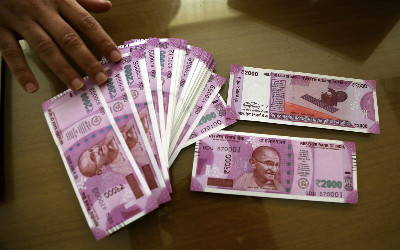

The United Arab Emirates Dirham (AED) pegged to the US dollar is on a roller coaster ride. That is good news to the expatriates in the UAE. The big windfall follows the US dollar’s sudden strengthening.
Among the major expat groups, Indians and Filipinos are having a good time. The Indian rupee (INR) has been down in November and the average exchange rate was 18.8 against the dirham. Since UAE currency is pegged to the US dollar, a zooming dollar means expatriates can send more rupees or euros with their dirham earned.
For example, the remittance volumes to the Philippines shot up 30 percent, according to an exchange in Dubai.
Promoth Manghat, chief executive officer of UAE Exchange Group told Gulf News that if the US dollar continues to maintain the strength, the UAE dirham “will provide an opportunity for the expats,” especially those from South Asian countries in leveraging the favourable exchange rate as many of their home currencies are on a depreciating trend.
“The dirham is pegged to the US dollar, which is enjoying a strong period, based on economic news from the United States. This means that the dirham is gaining strength against currencies, such as the Indian rupee and Philippine peso,” noted Sudhesh Giriyan, COO of Xpress Money.
Indian Rupee (INR) –AED exchange rate Trends- Highest: 18.511 INR on 27 Jun 2016.
- Average: 18.2478 INR over this period.
- Lowest: 18.0369 INR on 11 Oct 2016.
Meanwhile, the election of Donald Trump to US presidency has triggered a dramatic dollar rally and the greenback had its strongest weekly performance against the euro since February and the best performance against the yen since July.
On Friday, Nov 11, dollar made gains during the U.S. trading day, by reversing a small decline in the Asian session. This followed investors expecting infrastructure spending promised by Trump would force the Federal Reserve to raise interest rates more quickly.
The greenback rallied on the expectation that Trump’s plans for increasing fiscal stimulus would embolden the Federal Reserve to raise interest rates more quickly. Despite Friday’s drop, the greenback logged a weekly gain of 3.5 percent against the yen.
Markets are hopeful of a more pragmatic President Trump. Comments from the Trump camp put to rest speculation that Fed Chair Janet Yellen may be asked to resign. Markets hope that President Trump would not be a protectionist in economy and trade as perceived on the campaign trail.
Thanks to that sentiment, the US Dollar regained much of its lost ground against the Euro and trended flatly against the Pound. It is clear that investor anxiety over the result of the US election has eased after Donald Trump’s acceptance speech that less inflammatory.
Pound Turns Darling CurrencyNow UK’s Pound Sterling is at its strongest levels in five and six weeks against the Dollar and Euro, after the recent rally.
The GBP to USD rate has crossed above 1.2606 at the time of writing, having recovered from a 48-hour low at 1.2354.
According to Robin Wilin, an analyst at Lloyds Bank, GBP is turning into a 'darling' currency post-US election. He hailed the British currency’s gain and managing to rally against the USD through recent range highs ~1.2550.“Next resistance lies in the 1.2645, while key medium-term resistance is above in the 1.28-1.30 region. We are still biased for a medium-term range to develop and expect to see that upper resistance area capping in this regard,” he added.
What has been remarkable is crossing the resistance level of 1.2557, particularly when the US Dollar is having a good time on global markets, according to analysts.



